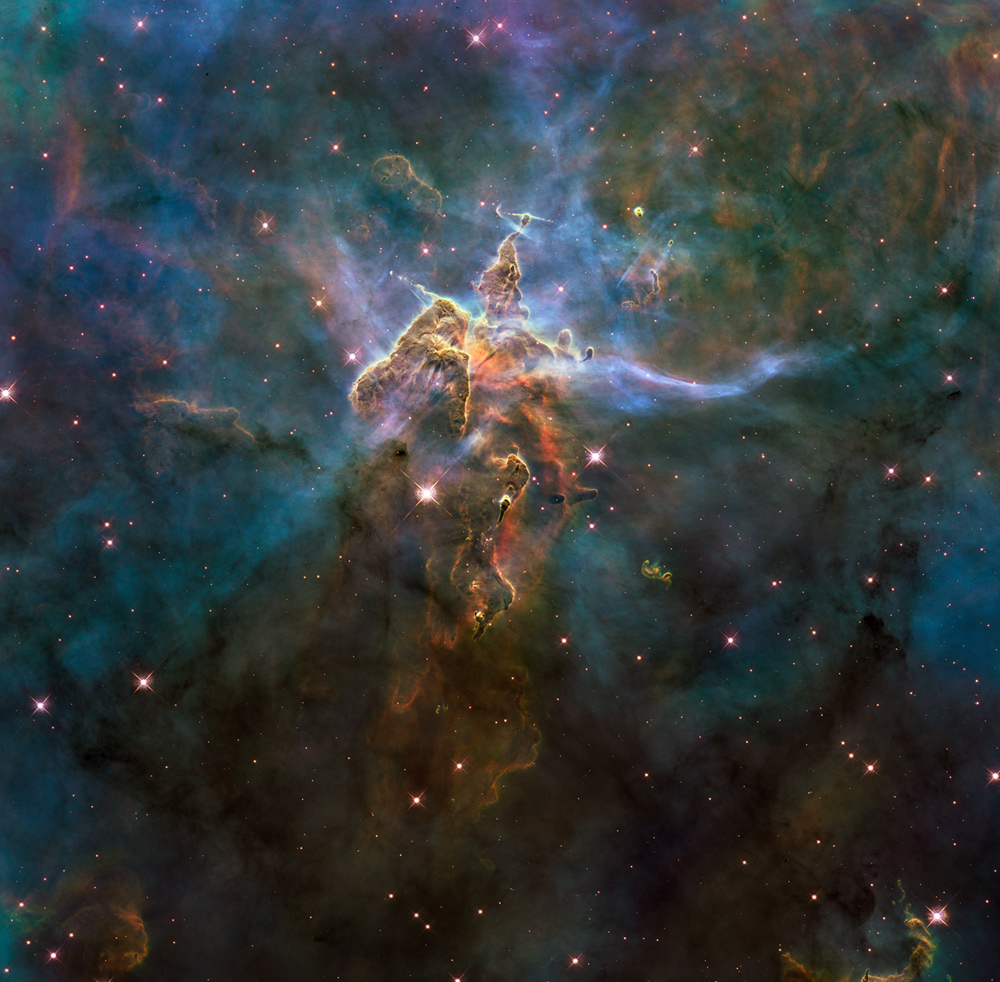

April 22, 2010
Release No.: 10-092 (STScI-2010-13)
Gas Pillar in the Carina Nebula:
This craggy fantasy mountaintop enshrouded by wispy clouds looks like a bizarre landscape from Tolkien's "The Lord of the Rings" or a Dr. Seuss book, depending on your imagination. The NASA Hubble Space Telescope image, which is even more dramatic than fiction, captures the chaotic activity atop a three-light-year-tall pillar of gas and dust that is being eaten away by the brilliant light from nearby bright stars. The pillar is also being assaulted from within, as infant stars buried inside it fire off jets of gas that can be seen streaming from towering peaks.
This turbulent cosmic pinnacle lies within a tempestuous stellar nursery called the Carina Nebula,
located 7,500 light-years away in the southern constellation Carina.
The image celebrates the 20th anniversary of Hubble's launch and deployment into an orbit around Earth.
Scorching radiation and fast winds (streams of charged particles) from super-hot newborn stars in the nebula are shaping and compressing the pillar, causing new stars to form within it. Streamers of hot ionized gas can be seen flowing off the ridges of the structure, and wispy veils of gas and dust, illuminated by starlight, float around its towering peaks. The denser parts of the pillar are resisting being eroded by radiation much like a towering butte in Utah's Monument Valley withstands erosion by water and wind.
Nestled inside this dense mountain are fledgling stars. Long streamers of gas can be seen shooting in opposite directions off the pedestal at the top of the image. Another pair of jets is visible at another peak near the center of the image. These jets (known as HH 901 and HH 902, respectively) are the signpost for new star birth. The jets are launched by swirling disks around the young stars, which allow material to slowly accrete onto the stars' surfaces.
Hubble's Wide Field Camera 3 observed the pillar on Feb. 1-2, 2010. The colors in this composite image correspond to the glow of oxygen (blue), hydrogen and nitrogen (green), and sulfur (red).
As the Hubble Space Telescope achieves the major milestone of two decades on orbit,
NASA, the European Space Agency (ESA), and the Space Telescope Science Institute, or STScI, in Baltimore
are celebrating Hubble's journey of exploration with a stunning new picture and several online educational activities.
There are also opportunities for people to explore galaxies as armchair scientists
and send personal greetings to Hubble for posterity.
NASA, ESA, and STScI are releasing a new Hubble photo of a small portion of one of the largest known star-birth regions in the galaxy, the Carina Nebula. Three light-year-tall towers of cool hydrogen laced with dust rise from the wall of the nebula. The scene is reminiscent of Hubble's classic "Pillars of Creation" photo from 1995, but even more striking.
NASA's best-recognized, longest-lived and most prolific space observatory was launched April 24, 1990, aboard the space shuttle Discovery during the STS-31 mission. Hubble discoveries revolutionized nearly all areas of current astronomical research from planetary science to cosmology.
Credits:
Mario Livio, Space Telescope Science Institute, Baltimore, Md.
Ray Villard, Space Telescope Science Institute, Baltimore, Md.
J.D. Harrington, NASA Headquarters, Washington
Other images, videos and press-release texts are available in the World-Wide Web, at
Starry-Eyed Hubble Celebrates 20 Years of Awe and Discovery
(HubbleSite - NewsCenter).
Hubble fans worldwide are being invited to take an interactive journey with Hubble by visiting Celebrating the 20th Anniversary of the Hubble Telescope (NASA).
![]() Updated: April 24 '10
Updated: April 24 '10
Back: ARVAL - Image Gallery (HST: Gas Pillar in the Carina Nebula)
Messages: